Authentic Dakgalbi (Spicy Korean Chicken Stir-Fry)
Enjoy Dakgalbi, a spicy Korean chicken stir-fry with chicken thighs, cabbage, rice cake, and sweet potato in a rich gochujang-based sauce. Experience the authentic flavors of Korean cuisine in this hearty recipe.
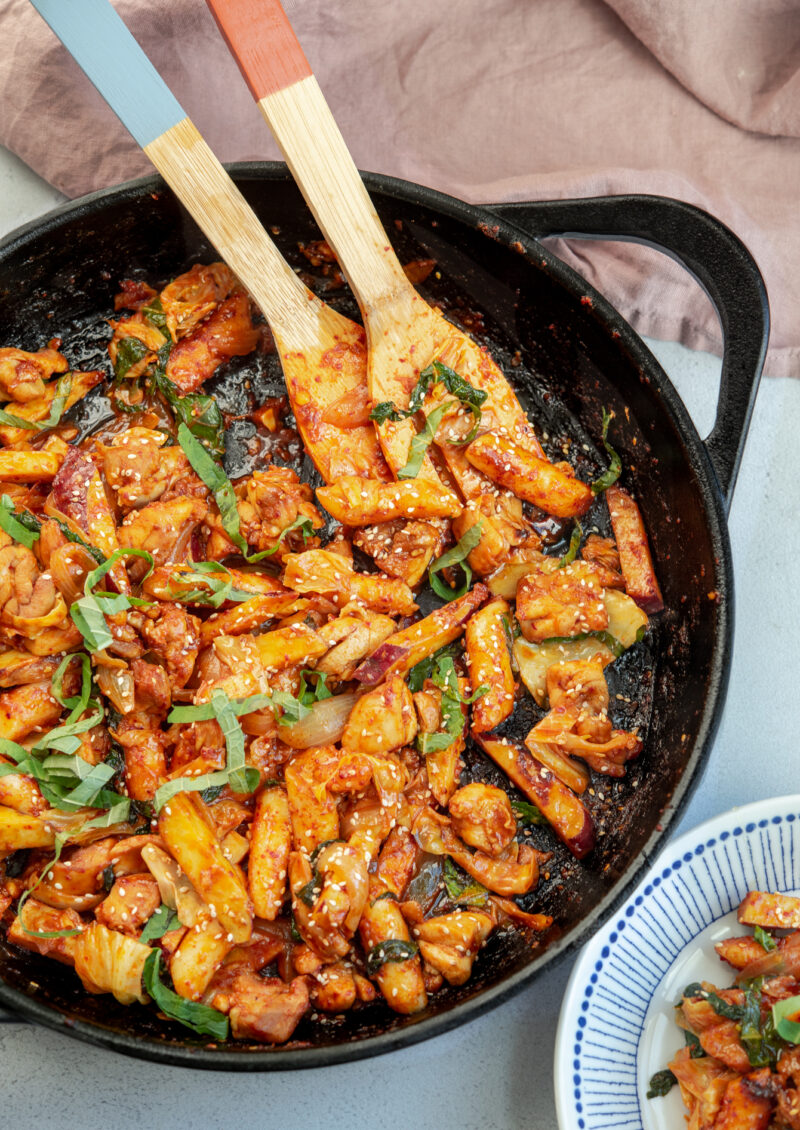
“I’ve made it couple of times to the exact specifications and it taste great. This is one of those dishes that I can’t get as good as I’ve had it in Korea.”
Susie
Some dishes are irrevocably tied to heartwarming memories. When I think of dakgalbi, my mind drifts back to a spontaneous train journey to Chuncheon, an eastern province in South Korea where dakgalbi is famous for.
My best friend, nursing a fresh heartbreak, and I were in search of distraction. Amidst the comforting conversations and clinking plates, we discovered this spicy chicken stir-fry.
With every bite, her sorrow seemed to melt away, replaced by laughter and shared stories. It’s truly remarkable how the right dish, at the right moment, can lift one’s spirits and remind us of life’s simple joys.
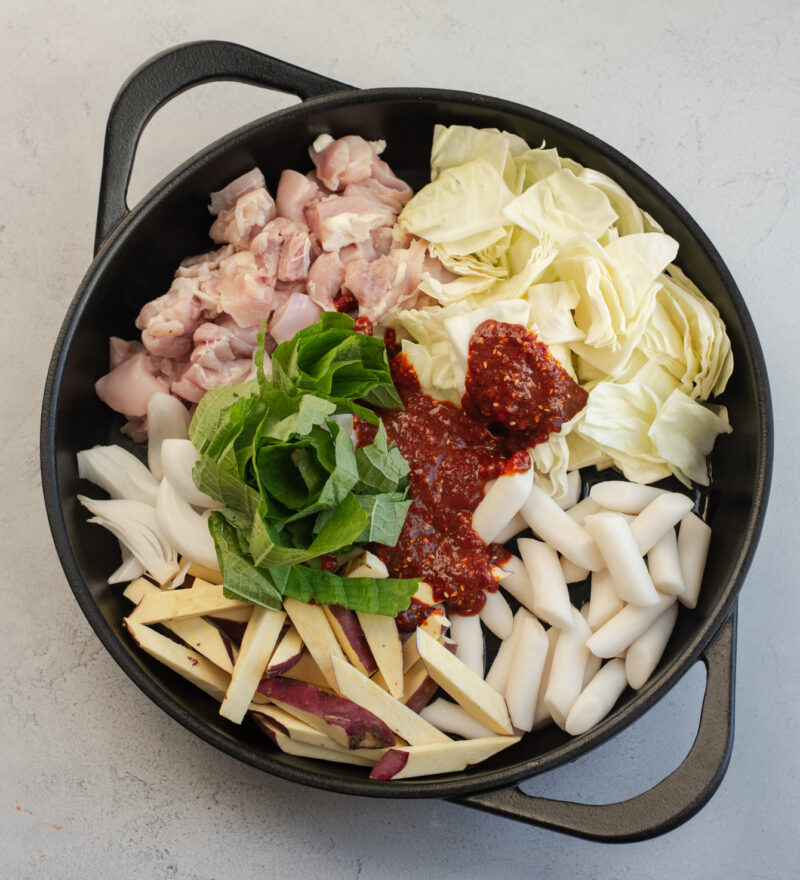
What is Dakgalbi?
Dakgalbi, sometimes confused with the Korean BBQ chicken recipe, is uniquely savory and spicy. The name combines “Dak” (chicken) with “galbi” (rib), illustrating the traditional grilling method similar to Korean beef ribs.
This spicy Korean chicken involves stir-frying chicken thighs with cabbage, rice cakes, sweet potatoes, and perilla leaves (kkaennip) in a robust gochujang sauce.
Although dishes like galbi-jjim, LA galbi, and galbitang also share the “galbi” name, each has its unique identity in the vast tapestry of Korean cuisine.
The Chuncheon Legacy
Introduced in the 1960s in Chuncheon, dakgalbi traces back to the city’s rich chicken farming heritage. This Korean chicken stir-fry quickly became a local favorite, distinguishing Chuncheon dakgalbi as the pinnacle of spicy chicken stir-fries.
While there are several varieties of spicy chicken stir-fry dishes in Korea, in my opinion, the local specialty of Chuncheon dakgalbi recipe is the most outstanding.
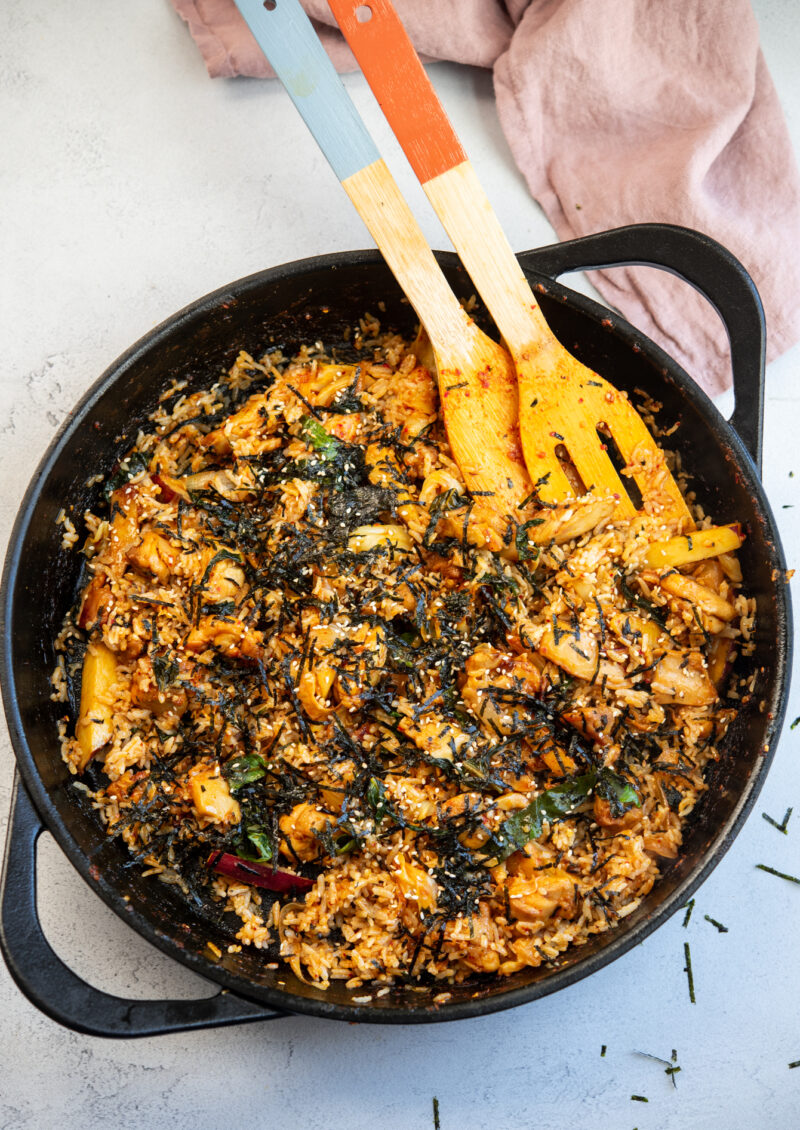
Experience Restaurant-style
At Korean dining spots, Dakgalbi is usually presented on a cast iron pan set atop a table with a central recess for a charcoal or gas burner. The attendant heaps the pan with chicken and accompanying ingredients, setting it over the flame to let everything sear and cook rapidly.
Once at the table, the server stirs the components until they’re soft and fully cooked. Patrons can then relish the steaming Dakgalbi with rice cakes and assorted accompaniments, blending them for a flavorsome and fulfilling dish.
Cheese Dak-Galbi
Modern variations include the trendy cheese dakgalbi. By melting mozzarella cheese into the dish, a creamy texture contrasts the spicy undertones. While it’s a departure from tradition, it’s a must-try for cheese lovers.
Bonus Dish: Dakgalbi Fried Rice
Post-dakgalbi, the fun isn’t over. Use remaining sauce and ingredients to whip up a flavorful dakgalbi fried rice. With roasted seaweed and a crispy rice layer, it’s the perfect encore to a satisfying meal.
Recipe Tips and Advice
- Skillet Selection: Choose a large skillet, like a cast iron or carbon steel one, that retains heat for an even stir-fry.
- Tableside Cooking: To elevate the experience, use a portable burner and cook right at the table.
- For the Fried Rice: After stir-frying, press down on the rice for a crispy bottom layer.
Essential Ingredients
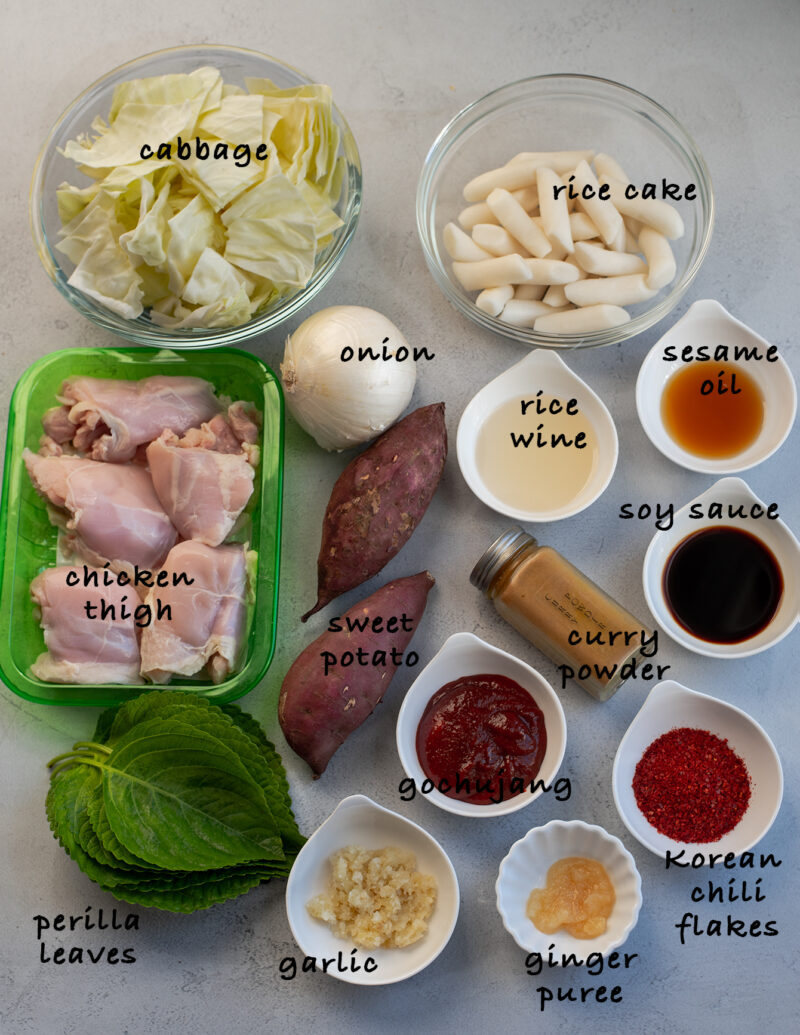
- Protein: Boneless, skinless chicken thigh.
- Veggies: Cabbage, onion, perilla leaves, and sweet potato.
- Extras: tteokbokki rice cakes (pre-soaked) and cooked rice for the fried rice variant.
For the Signature Dakgalbi Sauce:
Look into Korean pantry for ingredients. Gochujang and gochugaru bring spice, while garlic, ginger, curry powder, soy sauce, rice wine, and sesame oil layer in the flavor.
How to make Dakgalbi: Step-by-Step Guide
Step 1: Make the sauce by mixing all the ingredients in a small mixing bowl. Set aside 1 tablespoon of sauce if you are making fried rice at the end.
Step 2: Toss the chicken with 1/2 of the sauce in a mixing bowl and set aside to marinate.
Step 3: Soak the rice cakes in water for 10 minutes and drain. Dice the chicken thighs into bite-sized pieces. Dice the cabbage and slice the onion and perilla leaves. For the sweet potatoes, try to cut them into thin wedges or matchsticks.
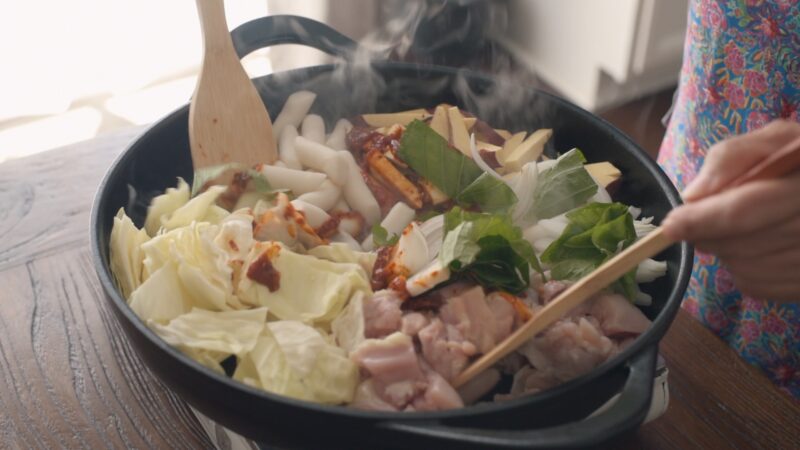
Step 4: Drizzle 2 tablespoon of oil in a large skillet. Arrange chicken, cabbage, rice cake, sweet potato wedges, onion, and half of the sliced perilla leaves in the skillet. Drizzle the sauce over the top and place the skillet on medium-high heat.
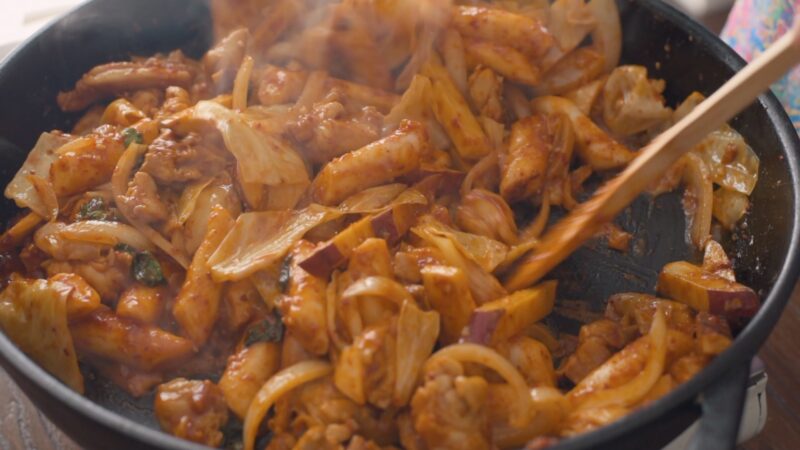
Step 5: When it starts to make a loud sizzling sound, begin tossing everything to combine. Stir-fry until chicken is fully cooked, and the rice cake and sweet potato are tender, about 6-7 minutes.
- If your food seems to be sticking too much to the skillet, add 2-3 tablespoons of water to create steam to release the sauce on the skillet and to cook evenly.
Step 6: Add the remaining perilla leaves toward the end of stir-frying. Serve immediately when it is hot.
Making Dakgalbi fried rice (optional)
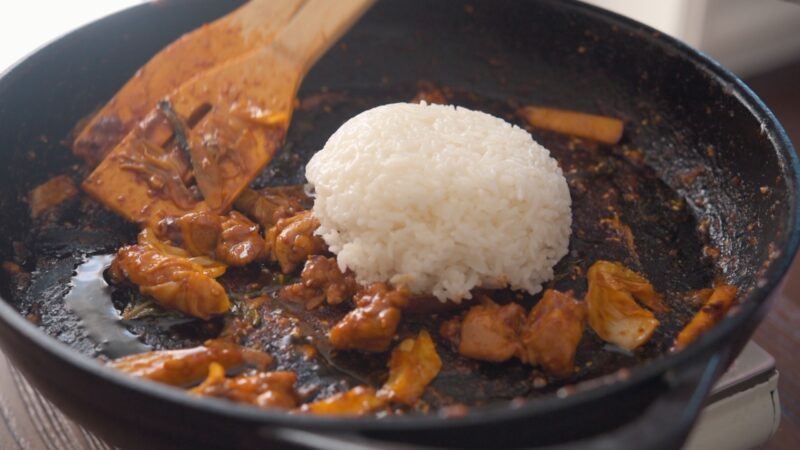
Step 1: To make the fried rice, turn the heat back to medium and drizzle 1 tablespoon of oil into the skillet. Add the cooked rice and reserved dakgalbi sauce, then start stir-frying to coat the rice with the sauce residue remaining in the skillet. Finally, add soy sauce and mix well.
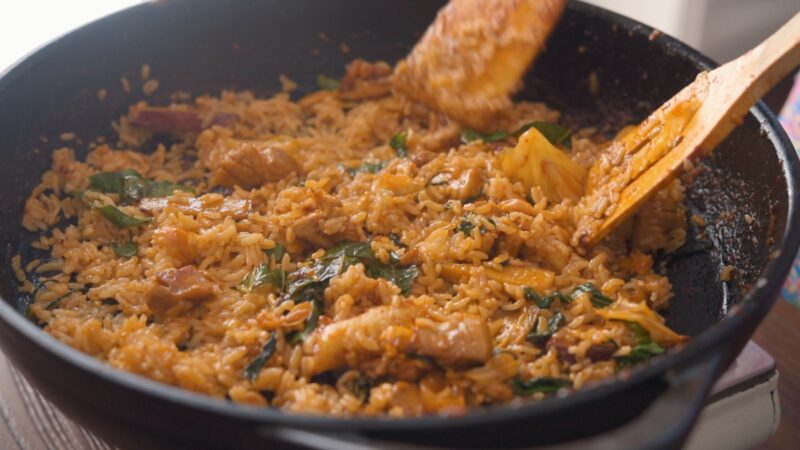
Step 2: Press the rice gently to the bottom of the skillet and let it crisp up for 1-2 minutes over low heat.
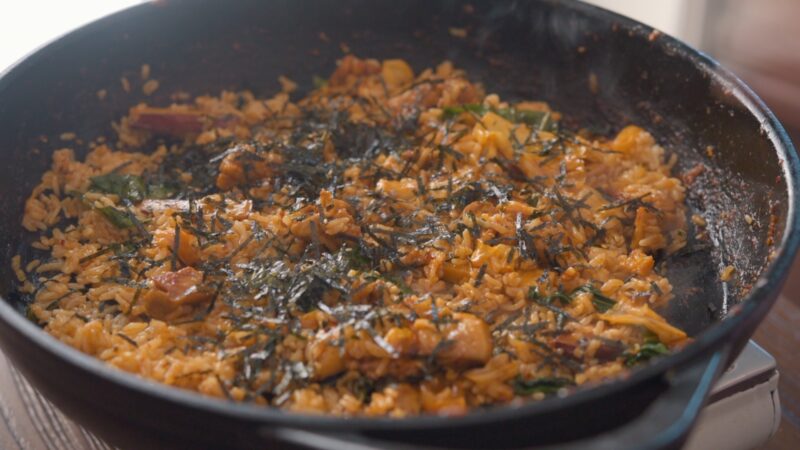
Step 3: Once the rice is golden and crispy, drizzle sesame oil, and sprinkle crumbled seaweed and sesame seeds. Toss everything together until well combined.
Serving Suggestions
Dakgalbi is a hearty and flavorful dish, and it pairs well with a variety of side dishes and accompaniments. Here are some serving suggestions:
- Rice: Serve over a bed of steamed short-grain rice or jasmin rice. The rice complements the spicy flavors and provides a balanced meal.
- Lettuce Wraps: Offer fresh lettuce leaves (like Romaine or Butterhead) for wrapping the Dakgalbi, along with a dab of ssamjang (spicy Korean dipping sauce). This provides a refreshing crunch and complements the spicy chicken.
- Korean Side Dishes (Banchan):
- Seasoned Spinach (Sigeumchi-namul): A light side dish that adds some greens to the mix.
- Spicy Cucumber Salad (Oi Muchim): A cold, spicy cucumber salad can be a refreshing contrast.
- Kimchi: The fermented, tangy taste of kimchi pairs wonderfully with the spicy Dakgalbi.
- Noodles: Pile over Korean sweet potato noodles (japchae) for a heartier dish.
- Drinks: Serve with traditional Korean beverages like Makgeolli (rice wine) or Soju.
- For non-alcoholic options, cold barley tea (boricha) or iced green tea would be refreshing.
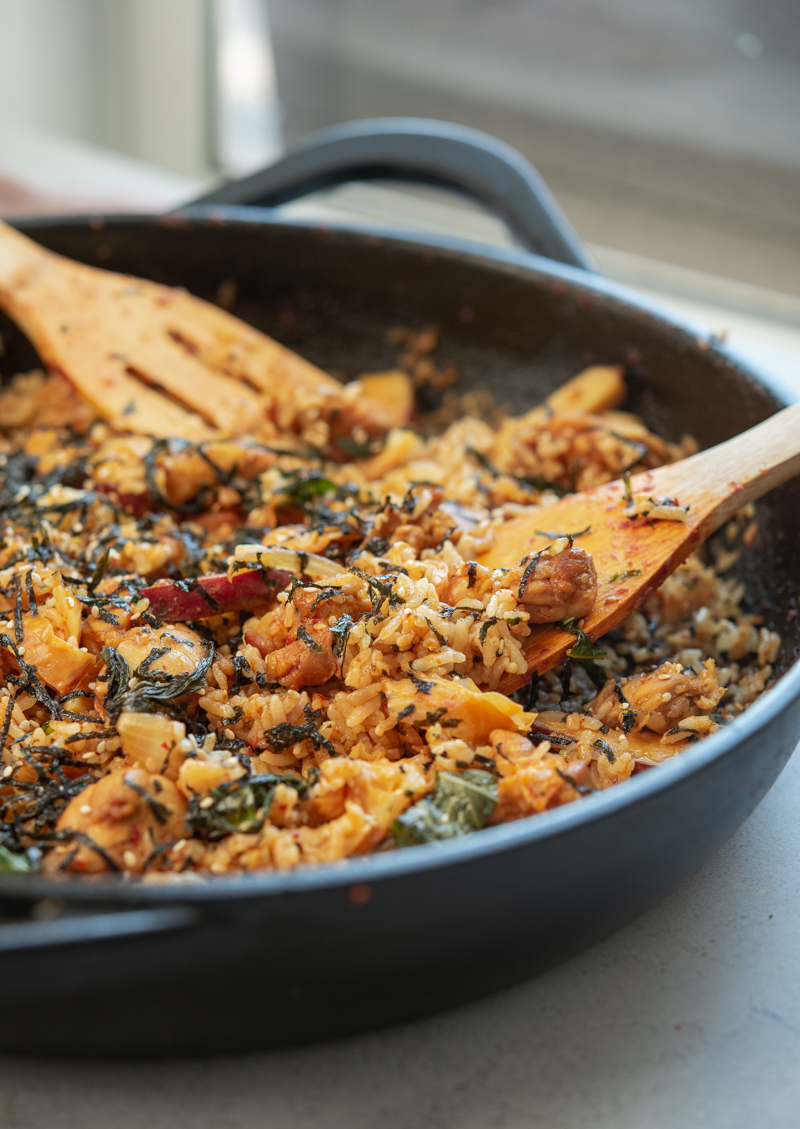
More Korean Chicken Recipes
Check out my chicken recipes for simple and easy meal ideas. Here are a few I like:
- Korean Fried Chicken (Chimaek)
- Spicy Korean Chicken Stew (Dakdoritang)
- Spicy Korean Chicken Soup (Dakgaejang)
- Korean Chicken Nuggets (Dakgangjeong)
- Chicken Bulgogi (Korean Chicken BBQ)
Did you love this spicy Korean chicken stir-fry? Share your dakgalbi experience in the comments below, or explore more authentic Korean recipes here. Don’t forget to share this recipe with fellow food enthusiasts on social media!
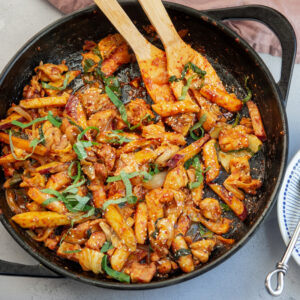
Authentic Dakgalbi (Spicy Korean Chicken Stir-Fry)
Recipe Video
Ingredients
For dakgalbi
- 1 lb (450 g) boneless, skinless chicken thigh, diced
- 2 tbsp oil
- 1/2 lb (225 g) Korean rice cake sticks
- 1/4-1/2 green cabbage, diced
- 8-10 perilla leaves + more, sliced
- 1/2 large onion, sliced
- 1 medium sweet potato, sliced into 1/4-inch thick wedges
- 2 tbsp oil
- 2-4 tbsp water
- 1 tbsp toasted sesame seeds , to garnish
For dakgalbi sauce
- 3 tbsp Korean chili paste (gochujang)
- 2 tbsp soy sauce
- 2 tbsp Korean chili flakes (gochugaru)
- 2 garlic cloves, minced
- 2 tsp curry powder
- 1 tsp ginger powder
- 2 tbsp sweet rice wine (mirim)
- 1 tbsp sugar
- 1 tbsp sesame oil
- 1 tsp pepper
- 1 tbsp Korean corn syrup (mulyeot), optional
For optional fried rice
- 1 tbsp oil
- 2 cup cooked rice
- 1 tbsp dakgalbi sauce
- 1 tbsp soy sauce
- 1 tbsp sesame oil
- 2 handful crumbled roasted seaweed
- 1 tbsp toasted sesame seeds
Equipment
- portable burner optional
Instructions
For the dakgalbi sauce
- To make the dakgalbi sauce, combine all the sauce ingredients in a small bowl. Set aside 1 tablespoon of sauce if you are making fried rice at the end.
For stir-frying dakgalbi
- Toss the chicken pieces with 1/2 the sauce in a mixing bowl and set aside.
- Soak rice cakes in water for 10 minutes and drain.
- Drizzle oil in a cast iron skillet, spread the chicken and top with vegetables (only 1/2 the amount of perilla leaves) and rice cakes. Drizzle the remaining sauce over and bring the skillet over med-high heat.
- When it starts to make a loud sizzling sound, begin tossing everything to combine. Stir-fry until chicken is fully cooked, and the rice cakes and sweet potato are tender, about 6-7 minutes. If your food seems to be sticking too much to the skillet, add 2-3 tablespoons of water to create steam to release the sauce on the skillet and to cook evenly.
- Add the remaining perilla leaves toward the end of stir-frying. Sprinkle with toasted sesame seeds and serve immediately when it is hot.
To make fried rice
- After finishing dakgalbi, turn the heat back to medium and drizzle 1 tablespoon of oil into the skillet. Add the cooked rice and reserved dakgalbi sauce, then start stir-frying to coat the rice with the sauce residue remaining in the skillet. Finally, add soy sauce and mix well.
- Press the rice gently to the bottom of the skillet and let it crisp up for 1-2 minutes over low heat.
- When the rice sticks to the skillet and becomes golden and crispy, drizzle sesame oil over the top and sprinkle crumbled seaweed and toasted sesame seeds. Toss everything together until well combined. Serve the dakgalbi fried rice immediately while it's still hot and crispy.

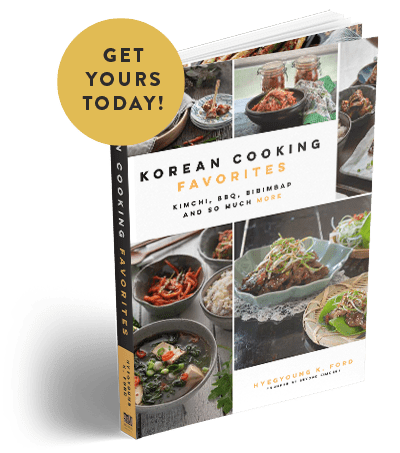
Thanks
Hi Holly
This is the first time I have made a Korean dish especially at 12 years old
my family was very happy when they tasted it
thank you for this dish
Hi Sabiha
I am so happy to hear that. What an amazing girl you are! You are so sweet and your family is so lucky to have you. Keep up the good work! Thanks for leaving the comment. You made my day!
Holly, Thanks for this great recipe. I’ve made it couple of times to the exact specifications and it taste great. This is one of those dishes that I can’t get as good as I’ve had it in Korea in Los Angeles even though L.A. has great Korean food. And your recipe is as good as I’ve had it a Korean restaurant so I’m so happy to have it.
Made this last night. We have no leftovers. I followed your recipe EXACTLY – even the palm sugar. I think this is the 6th or 7th recipe of yours’ I’ve made. My boys officially love you.
Great, Lisa! I am glad that your family loved this dish.
Thank you for such a delicious recipe! I’ve made it quite a few times, and have even used it as a way to impress Koreans with my skills. Making it on Thanksgiving for some friends as a poultry dish that I can still make in my small city in China, with only one hotplate and no oven! I’m looking forward to it already 🙂 (Also just realized this is my second time commenting on this recipe. Guess I really like it!)
I just realized that this is one of those recipes I’ve made several times over the years, but I’ve never thanked you for sharing. We adore it at my house. Cheers!
Thank you. That is so sweet of you.
This dish looks amazing. Curry does give different spiciness than the other chili peppers. As a spicy food lover, I definitely will make this dish. Thanks for sharing the recipe and the story, love it.
I think someone has “borrowed” one of your dak galbi images
http://aussietaste.recipes/chicken/dak-galbi-korean-spicy-grilled-chicken-and-vegetables/Hi Patty
Thanks for letting me know about this. It does look like they did not only just “borrowed” my dak-galbi photo, but also the recipe itself as well without my permission. I will contact the site owner. Thanks for your support.
84 congested miles from a Korean supermarket, can rice cakes from an American supermarket be subbed? Also, I have Szechuan chili flakes, is that a reasonable substitution? Have the normal Italian style ones as well but often read of their lack of interchangeability
Hi Steve
I am not sure what American rice cakes are like. If you can’t access the chewy Korean rice cakes, you can omit them. Try making the fried rice with leftover rice at the end of serving as I mentioned on the post above.
You can use Szechuan peppers in place for gochugaru but they are hotter, so I would use a lesser amount. Or try mixing with your Italian peppers.
GREAT story! Mahalo for this; makes me want to get back to blogging! But if I make this I will have to cut waaay back on the chili factors, as the family is not heat-tolerant.
DO NOT USE CRUSHED RED PEPPER PEOPLE!!! Lol uhm, whoops, it was almost impossible to eat because it was so hot. I doubled the recipe and still only used 3 TBL crushed red pepper instead of 4 TBL. I will make this again because we could tell that the flavor was great, but I will remember the Korean chili flakes next time haha.
Hi Sarah
Korean chili flakes are not for everyone. It can be quite spicy. But I am happy to hear that you like the flavor, though.
We are actually really good with spicy food. Our problem was instead of korean chili flakes we used regular crushed red pepper. I googled it after the fact and read that they should not be interchanged and crushed red pepper has seeds making it hotter lol. I found some perilla leaves today though (we used basil last time), so I will be making it again this week with korean chili this time. 🙂
:-)! Loved your story, Holly! And yes, as you have shown, super delicious food can make heartache go away… Interesting use of curry in Korean food too.
Thanks for this wonderful recipe and the interesting insight on love and food 🙂
What brand of rice wine did you use? I bought one but its alcohol content is 30%. I think it’s too high, isn’t it? How much is yours?
The alcohol will evaporate as it cook. I wouldn’t worry about the alcohol content in your rice wine. You can even omit it if you want.
Cooked it today (again) and it was delicious (again). Thank you for your labour of love!
Hi, I really want to try this dak-galbi recipes, but I have 1 question.
About the rice wine, since I couldn’t consume rice wine (or any kind of wine), could we leave or replace them with something? By changing or leaving them, would it make the taste different?
Thank you.
Hi Dewl, You can eave out the rice wine. It won’t change the flavor much.
This spicy chicken looks delicious! It is perfect for cold winter days.
Love your story! It’s very cute to compare soggy noodles with ex-boyfriend 😉 I believe good food brings comfort anytime in life.
Thanks Cecilia.
This is awesome!! Dak Galbi is one of my favorite Korean dishes but I just always assumed it would be really difficult and time consuming to make… This recipe is perfect! Can’t wait to try it out 🙂
Thanks for this delicious and very well-written recipe. I was stationed in Chuncheon as an officer in the US Army in the late ’80s, and some of my fondest memories of that time revolve around evenings spent at one of the array of restaurants, all clustered together at the center of town, that all featured Dak Galbi exclusively on their menus. When I went back to Seoul years later, I was surprised to find that this particular dish was such a Chuncheon specialty that even though everyone seemed to know and love it, nobody knew of anyplace outside of Chuncheon that served it (as anyone who has ever eaten in any one of the 500 or so Ray’s Pizzas in NYC, such a thing would never happen in the US, where there would be no shortage of folks claiming to have invented the recipe in their own home town). I’ve recently not only found a great Dak Galbi chain in Seoul, but also an impressively authentic version here in the LA area as well. Yours, though, is the best version of a cook-at-home recipe I’ve seen, and I’m excited to try my hand at it here soon. Thanks again!
Made this for the second time, and somehow, it’s gotten even more delicious! Not many one-dish meals are this impressive, but this is really so satisfying.
Great to hear that, Mehkko! I love this recipe and it is truly satisfying to me, too. 🙂
When i was stationed in Seoul, there was a warming gate that when you exited, there was a restaurant that served Dak Galbi. So many memories. Going out later today to find the ingredients.Thank you so much.
Thanks for this recipe! It was so good!! Since we can’t go back to Chuncheon anytime soon, this helps satisfy our craving!
Is there a substitute for rice wine..?
You can omit the rice wine in the recipe. It won’t change the taste much.
I made this for dinner tonight. Delicious.
hey Holly,
my bestfriend and i lived in Chouncheoun for a year and would try a different dak galbi resturant every weekend. our fav one was just around the corner and the family that ran it were amazingly friendly and by the end of or year we were like there adopted daughters! kkk so miss that place and the soju! cheers for the recipe.
Thanks for the recipe! Tried this and it was truly delicious!
Just found your blog..Thank you for the stories and the great recipes. on my way to the OMart to get what i dont have to cook this
This looks AMAZING! Can’t wait to cook this. I am from South Africa and I lived in Korea for a year and I really really miss Korean food so much. I miss everything about Korea 🙁
I’m am trying to get all my friends to open their minds and try Korean food.
Thanks for an amazing and inspiring blog. Looking forward to hosting my next Korean dinner party. 🙂
holly –
just wanted to say i LOVE your site. i have been SCOURING the internet for some traditional korean recipes and yours is hands down THE BEST- i have already made the scallion pancakes – love! – and one of your pork dishes! i cant say enough good things about your food! i cant wait to make this for my husband. he is very wary of korean food because he doesnt like fish but so far has absolutely raved about your dishes. After i made the tuna pancakes he said – “what makes that korean?! thats just delicious!” – i am so excited to make this chicken because i have a well seasoned cast iron skillet – his cooking “baby” – and he will be thrilled that i used it. Thanks to your site my husband and i are cooking these new dishes together – i am having a lot of fun introducing him to the culture and the cuisine. (side note: i am a HORRIBLE cook. i burn water and i dont know the difference between garlic and scallions BUT your site has made me quite popular! my mom cant believe im in the kitchen and my husband cant believe how “good i am” now at cooking) a thousand thank yous! khamsam-mida
Thank you Shay. I am so happy to hear that everything turned out great. I don’t believe you are a horrible cook. I think you have quite a talent in cooking. Keep up the good work. Tell your husband how lucky he is to have a wife who cooks great Korean food. Wife like you doesn’t come easily. 🙂
Please let me know if you need any help with my recipes. Have a great week!
I was stationed at Camp Long, Wonju, South Korea near the birthplace of this masterpiece. It’s still my favorite food of all time. I wish there was a Dak Galbi restaurant around Pittsburgh.
First of all ..it looks like a wonderful recipe.. I will try to make it with whateva I have in India but I must congratulate you for the beautiful writeup and equally good pictures.. loved your blog ..
God bless you
Holly, I made this for my boyfriend tonight (ironic, given the story?) and it was a huge hit! Thank you for sharing your recipes and congratulations on the magazine publication!
Thank you Jodi. I’m glad that your boyfriend loved it. Food brings people to be closer. I hope you had a great time with him through this chicken galbi.
Holly,
Thank you for this recipe. I have been searching for this for about 4 years now. There was or is (not sure)this resturant I used to eat this at all the time when I was in Korea. I know it is in Seoul around Sookmyung Women’s Univ. area. I don’t recall the name because I didn’t know the language at the time. I knew how to walk there because I recongnized certain stores. My friends and I would go there EVERY Saturday afternoon to eat this delicious Dak Galbi. I remember the man that served it to us everytime we went would add cheese (not sure what kind), but it was the best thing ever!!!!!!!!!!!! I especially love the rice cakes. It would not be the same dish without them! I am so excited to try this with my family. Thank you a million times for this!!!! Now I just need a cast iron skillet enought to feed about 6 people!!
Hi Pricilla
I am glad that you get to find this recipe, too. It is one of the famous Korean chicken dish and I hope this is the one you’ve been looking for. Yes, rice cake is the must here. I never had one with cheese on top but thinking of it make me drool. A Cast iron big enough to cook to feed more than 6 people can be extremely heavy. Try paella pan. Look for the one with carbon steel and they come in big sizes and not as heavy.
Just made this dish for my Korean friend who was craving it. It turned out fantastic! She loved it and couldn’t stop eating it (and she’s very picky)!
That is so great to hear, Tracy. This is one of my treasured recipe and I am so happy to hear how much people enjoying it. You are such a great person to cook for your friend.
Huge thanks for this recipe! I’m not a well-seasoned cook but it was extremely easy to execute and turned out awesome. Nothing like the sounds and scents of 닭갈비 bubbling away: http://youtu.be/lX10U32ABD0
-ian
Okay, you’re officially one of my favorite websites! Made this dak galbi for my family and they loved it! At my local Korean market, the owners helped me find the Korean corn syrup and asked what I needed it for. I went back in today and I’m now known as
“Dak Galbi!” 🙂
That is funny, Leslie. We use the Korean corn syrup in many dishes. I am glad that your dak galbi turned out so well. I am so craving the dish now.
I had something like this (probably nothing like this, haha) in Seoul once..but it had squid in it too.. I think it was calles Ossam or something like it, is that something you recognize? Id love to make it again, but am unsure of exactly what was in it..
Hi L, the word Ossam doesn’t sound familiar to me. Do you mean Bossam? It is braised pork belly wrapped with lettuce and spicy toppings. For this dak galbi recipe you can substitute with seafood, like squid, of course.
Oh wait, Im so stupid.. it wasnt chicken though, sorry. It was pork.. sp I think the name was a play on words with ochingo and samgyopsal, does that ring a bell?
Anyway, this looks delicious and I’ll surely be making it soon.^^
I’m am soooo excited to make this!! I think my husband of 11 years just fell in love with me all over again. He was station in Chuncheon, Korea right after we got married and when I went to visit him there he took me to have dak galbi and I loved it and everything about Korea! We would tell other koreans about it when we got back stateside but they would look at us like we were crazy, now I know I am not!! LOL!! We live in Kuwait now but I will hunt down or order these ingredients online if they will let me. I’m just wondering if the perilla leaves can be found here? We don’t have a lot of korean grocery stores (if any) but we do have phillipino stores maybe they might have it?
Hi LiAna, I am so happy to hear that someone had the same dish in Chuncheon city. Isn’t this dish delicious? Perilla can be tough to find in Kuwait. Mostly Japanese and Koreans use this culinary leaves and I am not sure any SE Asian uses. If you can’t find, substitute with basil and mint.
Hi LiAna, I am so happy to hear that someone had the same dish in Chuncheon city. Isn’t this dish delicious? Perilla can be tough to find in Kuwait. Mostly Japanese and Koreans use this culinary leaves and I am not sure any SE Asian uses. If you can’t find, substitute with basil and mint.
Glad to of found your blog, Holly! This recipe looks delicious:) can’t wait to try it xoxo
Thanks Juju.
Aside from this recipe looking absolutely delicious, I especially love the stories that come with your food =D
I love Korean rice cake. This look so good. I started to drool when you started to cook. Perilla is one of my favorite herbs and I use it a lot for my cooking. Gosh your step by step pictures are so good that I’m intrigued to pick up a piece while you are cooking! Wish my kitchen is bright and pleasant like your kitchen!
Thanks Nami. Actually my kitchen is quite dark. I have to turn on the light during the day. My dream kitchen will have a huge window in one wall to bring all the natural sunlight into the kitchen. Someday…, crossing my fingers!
Hi Holly, thanks for sharing this recipe! I bought the ingredients this past weekend, so I’m looking forward to making this dish later this week.
One question, I do not have ground ginger, but I do have real ginger. Can I use real ginger instead and how much would be appropriate? I also have other dry ingredients, so if there are other options, I look forward to hearing from you.
Thanks again!
Of course you can use the fresh ginger. Use double the amount of dry ginger in minced form. You can use the dried garlic powder instead of fresh, possibly less amount than fresh garlic. Have a fun making the dish. It will be spicy but very delicious!
Wow, this looks great. I really need to track down some Korean Chili Paste. And I’ve never used perilla before, although I’ve heard of it. I didn’t know it tasted like a combo of basil and mint – and I have both in my garden. You suggest substituting sweet basil, but it sounds like I could add a bit of mint, too. Great recipe and a touching story about your friend. Thank you.
Yes, use both basil and mint. Isn’t it good to grow your own herbs?
Gochujang will never go to waste!!! I am an american irish girl who never tasted the stuff until I started bartending in a Korean restaurant when I was 24. Let me tell you I find myself trying to figure out ways to work it into mundane recipes. I mix it into chicken salad! I use it like crazy! Sharmin Ullah I would buy it if you can find it cus it really does have a unique, delish flavor that is all its own! BTW great recipe Holly I cant wait to make this!
Thanks Bridget for wonderful review on Gochujang. You are so right. Gochujang is so unique on its own and versatile you can use it for many dishes and be creative. I can’t live without it, honestly!
Holly, this looks amazing and even better with the story behind it. I am lucky to have and Asian store within walking distance from me and ours is owned by Koreans, so over the years I have become more and more familiar with Korean food. I just picked up some perilla leaves and they are in my fridge ready to use. I often get the sweet potatoes just like you, actually they had some it the other day. I have rice cakes just like that too. I am so excited to try this! I have some perilla oil, and I love the Korean sesame oil, such a good flavor. They make their own kimchee each week, and sell Korean sushi, and Korean sweet potato noodles for lunch on Saturdays. Okay back to reality!!
BTW – to answer your question you left on my blog. Cotjita cheese was found in the Latin section in the refrigerated area where you find the tortillas and other Latin cheeses. It is similar to Parmesan cheese, you could use that instead. HTH
Thanks Lyndsey. It is very difficult to find Latin groceries in Malaysia especially the Latin dairies. I actually never had Cotjita cheese and very curious about it. Similar to Parmesan? Interesting.
Looks delicious, Holly! This is my family favorite as well. I make this especially when my kids are home because they love it. Great story and recipe!
Looks great! And I’ve never had Korean food before. I was wondering if there was a substitute to the korean chili paste? I don’t want to buy an entire jar of it, just in case it goes to waste.
Thanks a bunch!
Hi sharmin
Korean chili paste is the main ingredient in the sauce and if you replace with other, it will change the flavor. Korean chili paste has rice powder in it so it thickens the sauce eventually. You can give a try to use Chinese or other Asian chili sauce but with the less amount.
This looks and sounds soooo amazing, will have to try it v soon, if I can get the ingredients.
Love the accompanying story too LOL.
I can almost imagine a korean drama coming from this post haha! My hubby and i love korean food, and this post just brings back memories of our holidays in seoul years ago when we accidentally found the best restaurant in insadong. Thanks for sharing the recipe, must try it one day.
And what restaurant is that? I’m going to seoul this summer and am trying to find the best gems!
This particular dish I had was in the restaurant in Chuncheon, 2 hours east of Seoul. However, there will be plenty of Dak galbi restaurant in Seoul these days. Just ask some locals and they will let you know which on is the best (for them at least).
Hello Holly,
I love the story. I think with every blog, it is always interesting to know that there is a story behind everything we do, be it cooking, travelling or whatever people blog about these days. It makes the main subject more attractive as food although delicious will only remain as food. But with a reference or story, it takes on a whole new meaning.
This is why memories are always associated with the food we eat.
There is a huge Korean supermarket near me and I buy most of my Chinese groceries there but because I do not know any Korean, I don’t know what to do with the Korean ingredients. The only Korean meal I had was in Hong Kong in a Korean Barbecue restaurant. I remember the crowds and the sizzling noises on the domed shaped pan placed on top of the gas burner. The smoke and steam together formed a formidable sight!
I will try and cook your receipes as the photos have shown what the various ingredients are. Thanks for the tutorials!
Thanks Nicole. I agree with you. I love reading article about food that has stories behind. It help me appreciate the dish even more. That’s why I like to read my cookbooks like a novel. Hope you can give dish a try if you can gather all the ingredients.
Wow this looks very delicious! But when you say “paella leaves” do you mean “perilla leaves” instead? Because I’ve bought those leaves at a Korean supermarket and they’ve always been labeled “perilla.” Paella is the Spanish seafood and rice dish, I think…
For the rice cakes, do they have to be the long type or are the oval kind also okay?
Apple, Yes, it should be Perilla, not Paella. I knew it was perilla, but I was writing this post very late at night and my brain was not functioning the way it should. Sorry for the confusion. Also I used the rice cake sticks but you can use the flat oval kind as well.
This looks delish! And great photos. Definitely makes me want to cook it but… absence of local stockist of rice cakes. I think it would still be delicious without, until I could get hold of rice cakes next time I’m near somewhere that sells them?
Thanks for posting!
You don’t need to add the rice cakes. Instead add udon noodles at the end. or fry with some cooked short grain rice at the end after you finish the dishes to slobber with the sauce.
Udon’s a great idea, and one of favourite noodles in this house – nothing more wonderful that watching my 8 month old squishing them in her hands and scooping them up into her mouth. It makes me feel very blessed 🙂
Thanks Holly
You could always make your own rice cakes. It is actually quite easy. 🙂
Whoa, that looks super delicious! This is one of my favorite dishes ever. I’ll try your recipe soon. I love your story too…comparing a lost romantic partner to soggy noodles…you have such an imaginative mind, haha! Small correction though, it should be perilla leaves, not paella.
Ooops! you are right Mike. It should be perilla leaves. Thanks for pointing that out. You can tell I am not a native English speaker.
Oh my lord that looks amazingly good. Even without hearing the story about how it helped your friend forget about her heartbreak, I’m already convinced. Though, of course, I really enjoyed hearing about that story, I love hearing about how food brings people together and creates special memories. lol about that first quote.